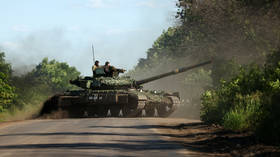This article is not intended for max or tangs to read, it is a given that the more accurate the analysis the less likely they are to read it.
And this article is very accurate judging by who is being quoted and what they have to say.
It shows just how poorly max and co have been able to comprehend the action over the last year , and really, just how deeply they are in denial .
Definitely worth skimming thru the article .
I posted some excerpts , the entire article is at bottom .
Enjoy -- it is always refreshing to see agreement from both sides defining the reality on the ground rather than read unsubstantiated opinion from truly ignorant HC posters
NATO’s ‘proxy war’ blues: How the US-led campaign to use Ukraine to ‘cripple’ Russia has failed Moscow has overcome Western economic sanctions and honed a bigger and more effective military through 18 months of combat Tony Cox, a US journalist who has written or edited for Bloomberg and several major daily newspapers.The US-led drive to isolate Russia and the attempt to debilitate its economy and military using Ukraine – acknowledged as a “proxy war” even by some Western leaders – appears to be having the opposite effect by various measures.
Washington and other NATO members have repeatedly proclaimed that Russian President Vladimir Putin has already suffered a strategic defeat in Ukraine and has “no possibility” of winning the conflict. “Putin’s already lost the war,” US President Joe Biden claimed last month after attending a NATO summit in Vilnius, Lithuania.
Grading the military impact
While assessments of the battlefield situation diverge wildly, NATO has clearly failed so far in its effort to weaken the Russian military. Moscow’s forces are inarguably stronger, better-armed and larger today than when the conflict started in February 2022. They’ve also gained 18 months of experience in fighting NATO-trained troops and countering NATO-supplied weaponry. In fact, Russian troops have become so formidable in this regard that even Western media outlets have quoted defense analysts on the increasingly effective tactics employed by Moscow’s battle-hardened forces.
Those experts have praised the Russian military’s abilities in shooting down Ukrainian drones, setting up redoubtable defensive lines, and destroying tanks and artillery units. Retired UK General Sir Richard Barrons contrasted Russia’s “textbook” defensive positions against the current Ukrainian counteroffensive with Moscow’s retreat last year from wide swathes of territory in the Kharkov and Kherson regions.
“If you add all that together, everybody knows this will be a harder fight than for Kherson and Kharkiv in the autumn of last year,” Barrons told Associated Press in June. He added that Ukraine’s backers have used Kiev’s successes in taking back territory last year as “benchmarks, which I think is unfair, unreasonable in the circumstances.”
The Center for European Policy Assessment (CEPA), which is funded by a variety of US weapons makers, offered a similar view on the strengthening of Russia’s military. “The Russians have gone to school on the Ukrainians and have been learning quickly,” Chels Michta, a US military intelligence officer, wrote in May. “The 2023 Russian Army is a different beast from the 2022 Russian Army from the early stages of the war.”
Another measure of the increased effectiveness of Russian forces is the fact that Kiev has reportedly abandoned the battle tactics preached by Western military trainers. In response to heavy losses by the nine NATO-trained brigades at the forefront of their counteroffensive, “Ukrainian military commanders have changed tactics, focusing on wearing down Russian forces with artillery and long-range missiles instead of plunging into minefields under fire,” the New York Times reported on August 2, citing unidentified US officials.
Securing enough artillery shells to sustain that strategy could be challenging. Biden and NATO secretary-general Jens Stoltenberg previously conceded that Kiev’s forces were burning through ammunition faster than their Western suppliers could replenish those stocks. Biden tried to justify his controversial decision last month to supply cluster bombs to Ukraine by saying the munitions – banned by more than 100 countries, though not by the US or Russia – were needed to make up for a shortage of artillery rounds. Meanwhile, Russian defense contractors have ramped up production, enabling Moscow’s forces to outgun a country backed by dozens of Western benefactors.
Russia also has more troops to work with than when the conflict began. More than 231,000 Russians have signed contracts to enlist so far this year, National Security Council deputy chief Dmitry Medvedev said on August 3. Moscow called up 300,000 reservists in 2022. After increasing the number of Russian combat troops by about 13% to 1.15 million, Putin approved a plan in December to expand by a further 30%, to 1.5 million, in the years ahead.
Despite the casualties suffered in Ukraine, Russian ground forces are clearly bigger than when the conflict began, US Army General Christopher Cavoli has conceded. Cavoli, who heads the US European Command, told US lawmakers in April that Russian naval and air-force losses had been minimal. He lamented, too, that Moscow’s forces in other parts of the world had become more active, even as more units were being moved into Ukraine.
Russian T-80 tank of the 200th motorized infantry unit of the Southern group of troops shoots from a firing position in the course of Russia's military operation in Ukraine. © Sputnik / RIA Novosti“The Russians are more active than we’ve seen them in years, and their patrols into the Atlantic, and throughout the Atlantic, are at a high level, most of the time at a higher level than we’ve seen in years,” Cavoli said. “And this is, as you pointed out, despite all of the efforts that they’re undertaking inside Ukraine.”
Grading the economic impact
Just as the alleged proxy war has inadvertently put Russia on stronger footing militarily, the US-led campaign to thrash the Russian economy has apparently missed the mark. In fact, it has backfired in some ways.
Washington and its allies imposed unprecedented economic sanctions on Moscow, and Biden vowed to impose “swift and severe” costs on Russia. However, Russian GDP contracted by just 2.1% last year, easily beating the World Bank’s prediction of an 11.2% decline. The economy is on track to grow by more than 2% this year, while the 20-member Eurozone has tumbled into a recession amid historically high inflation and declining standards of living.
“We have emerged from the crisis, and our prospects for rapid development are good by today’s standards,” Kremlin spokesman Dmitry Peskov said on August 3 at a youth forum in Moscow. “This is a unique situation. You will study how this was possible and where our country, our people, found such strength.”
Moscow has benefited from rising energy earnings – the government reported a 28% gain in oil and natural gas export revenue last year – and it has been forced to become more economically diversified. And just as the Ukraine crisis has prompted Western nations to cut or eliminate their reliance on Russian energy, it has effectively reduced Russia’s vulnerability to export markets that are geopolitically hitched to Moscow’s enemies.
Russia has ramped up exports to other countries to fill the void created by Western sanctions, building closer trading ties with non-hostile partners, including the world’s two most populous nations, India and China. Exports to the United Arab Emirates also have surged, according to a Bloomberg report earlier this month. The UAE is in talks with Moscow on a free-trade agreement with the Russian-led Eurasian Economic Union.
https://www.rt.com/news/581704-ukraine-proxy-war-backfires-for-west/
- Forums
- World Politics
- Russia Ukraine war
Russia Ukraine war, page-171270
-
- There are more pages in this discussion • 60,977 more messages in this thread...
You’re viewing a single post only. To view the entire thread just sign in or Join Now (FREE)
Featured News
Featured News
The Watchlist
ACW
ACTINOGEN MEDICAL LIMITED
Steven Gourlay, Managing Director and CEO
Steven Gourlay
Managing Director and CEO
SPONSORED BY The Market Online






